Posted by
Mordy Oberstein
Google’s early August algorithm update was one the most drastic changes I’ve ever had the ‘pleasure’ of studying. No site within any niche was safe. Not even the top results on the page could withstand its algorithmic inertia. Amidst the waves of rank fluctuations, a peculiar site pattern emerged, one that had us wondering… Can Google now profile your site?
Can the search engine determine the nature of your site’s intent, of what users believe your site is meant to do? If it can, what are the consequences of intent incongruity? What happens when you engage in behavior that Google believes is not behooving of your profile?

Site Patterns from the August 2018 Google Update Point to Profiling
When analyzing the early August update there were a few notable patterns. At the niche level, sites within the health and finance industries were most impacted. There was a clear and notable emphasis on Your Money Your Life (YMYL) sites. That
When I started looking into some of the sites that showed the biggest losses within those niches a few things began to stick out. Some of the characteristics of sites that saw losses were relatively traditional. For example, it seemed that health sites that were a bit too aggressive in their ad placements, though far from what would ever be called spammy, were not treated too kindly by the update.
At the same time, new indicators, ones I’ve never really seen before, began to emerge. Specifically, it appeared that sites that either included a substantial amount of content that did not align to the site’s overall purpose or those that used content and/or advertising to create a facade-like profile were heavily hit by the update.
Seeing this led us, most notably Rank Ranger founder Shay Harel, to believe that with the August 2018 update came a new ability to profile sites. That is, we believe that Google can now determine a site’s purpose and whether or not its content aligns with that purpose and if indeed a more covert or contradictory purpose exists.
While I briefly surveyed this in my initial post on the update, there has been some debate as to the relationship of the August 2018 update to YMYL sites. Due to that, I wanted to better make the case for a new profiling ability within the algorithm. To this extent, I surveyed and audited 8 YMYL sites that either lost or gained (mostly lost) organic visibility as a result of the August update. What follows is my analysis.
A Case by Case Study of Google’s Profile Algorithm

Before I get into the sites, I just wanted to briefly explain what I did. When analyzing the August update, and the sites impacted, I started to see certain tell-tale signs that a site that suffered a visibility loss may have been “profiled.” Among these signals were sites that are content heavy, and even
At the same time, I also started to see sites that seemed a bit too broad in their content scheme.
As a result, I have categorized Google’s site profiling into two segments:
1) Those sites that use ads or other forms of sponsorships in such a manner that a secondary site profile emerges.
2) Sites who present significant amounts of content that does not align
For the purpose of this study, and for the sake of being concise, I am going to henceforth refer to Google’s seemingly new profiling ability as Google’s profile algorithm (though I am in no way saying that a new algorithm called the ‘profile algorithm’ exists, I am simply saying there is a new algorithmic ability centered on site profiling).
Underlying E-Commerce Profiles Negatively Impacts Rank
When surveying the August update one set of sites stuck out like a sore thumb: Health sites whose foremost profile was informational (i.e., content-based) but had a secondary or less manifest e-commerce profile.
I just want to say before I proceed: I am not calling any of the sites I am about to discuss “spammy.” I’m simply pointing out a profile pattern and analyzing how site behavior may have resulted in a loss of rank during the August update.
That said, let’s have a look, shall we?
Site #1: livestrong.com
I’m starting here with this site because it is the most obvious example. When you visit the site for the first time (at least at the time of this writing) an enormous ad for an athletic apparel company asks you to start shopping (and even presents a video ad within the banner):
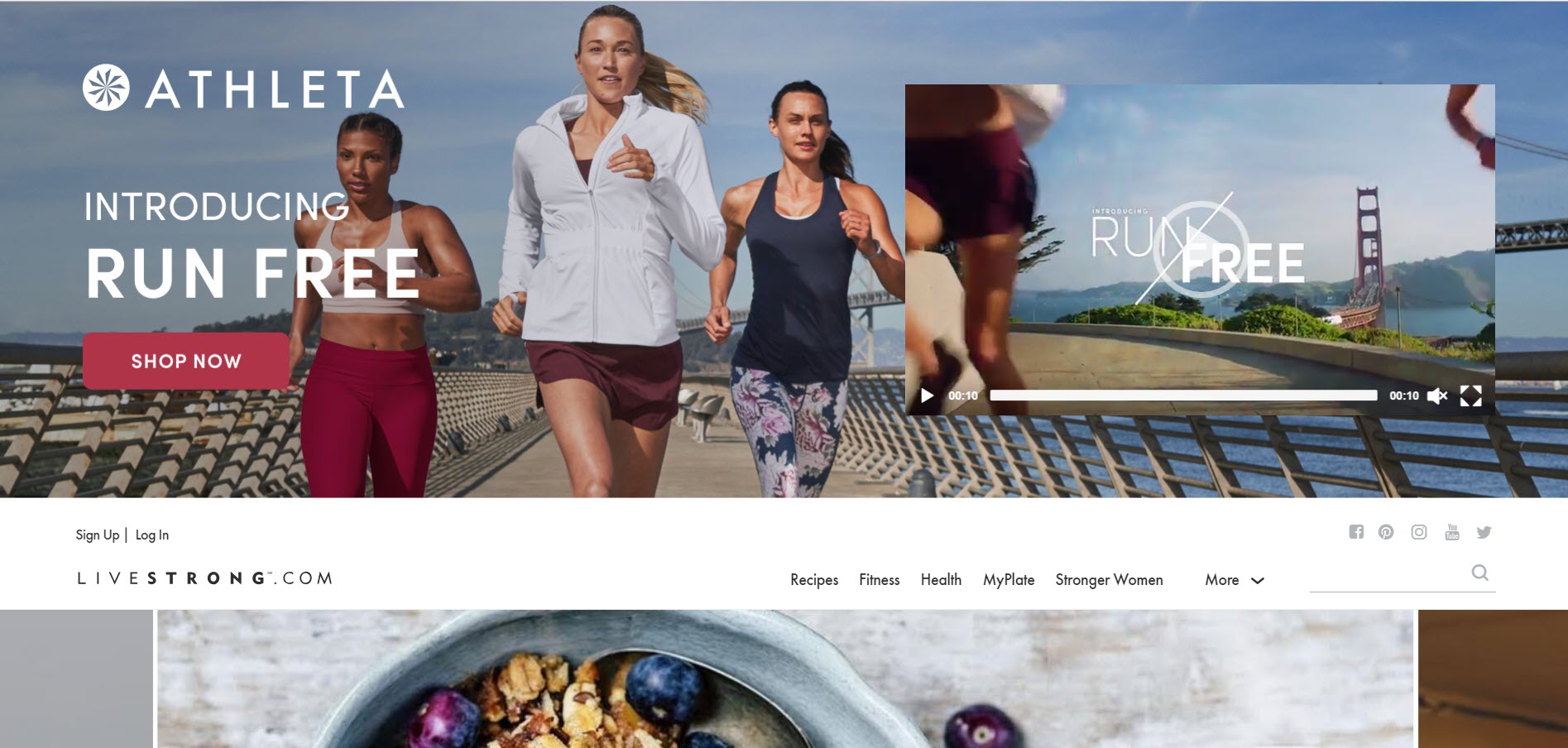
During the update this site loss 34% of its organic visibility. From a profile perspective, the reasoning is a bit obvious. Having an ad that eats up the majority of above the fold space, an ad that calls on you to start shopping, undermines the site’s informational profile. Instead, there is a strong e-commerce undercurrent.
The problem this presents is that YMYL sites are meant to be “safe.” At least that’s what Google says they should be within their recently updated Search Quality Rater Guidelines (more on this later).
Having a less than overt e-commerce undercurrent, at least according my theory, sends Google a signal that says you’re more interested in e-commerce than helping the user. This, of course, wouldn’t be a problem if in
In other words, it’s not the e-commerce profile per se that’s a problem, how could it be? It’s the competing profiles. It’s the secondary profile that negates the central intent profile of the site, and that sends forth the message that this site may be inconspicuously trying to sell rather than inform or at a minimum is not adequately focused and therefore “unsafe.” For the record, I don’t personally think this site is doing anything misleading, at least not intentionally. I think they just took a nice sum of money to run a big ad at the top of the page. But I don’t think that’s how Google sees it from a site profile perspective. Especially not for YMYL sites where Google seems to be very much erring on the side of caution.
Site #2: bodybuilding.com
During the August update, this site lost nearly 50% of its visibility. Like the livestrong.com site, looking at the site’s competing homepage profiles may explain why:
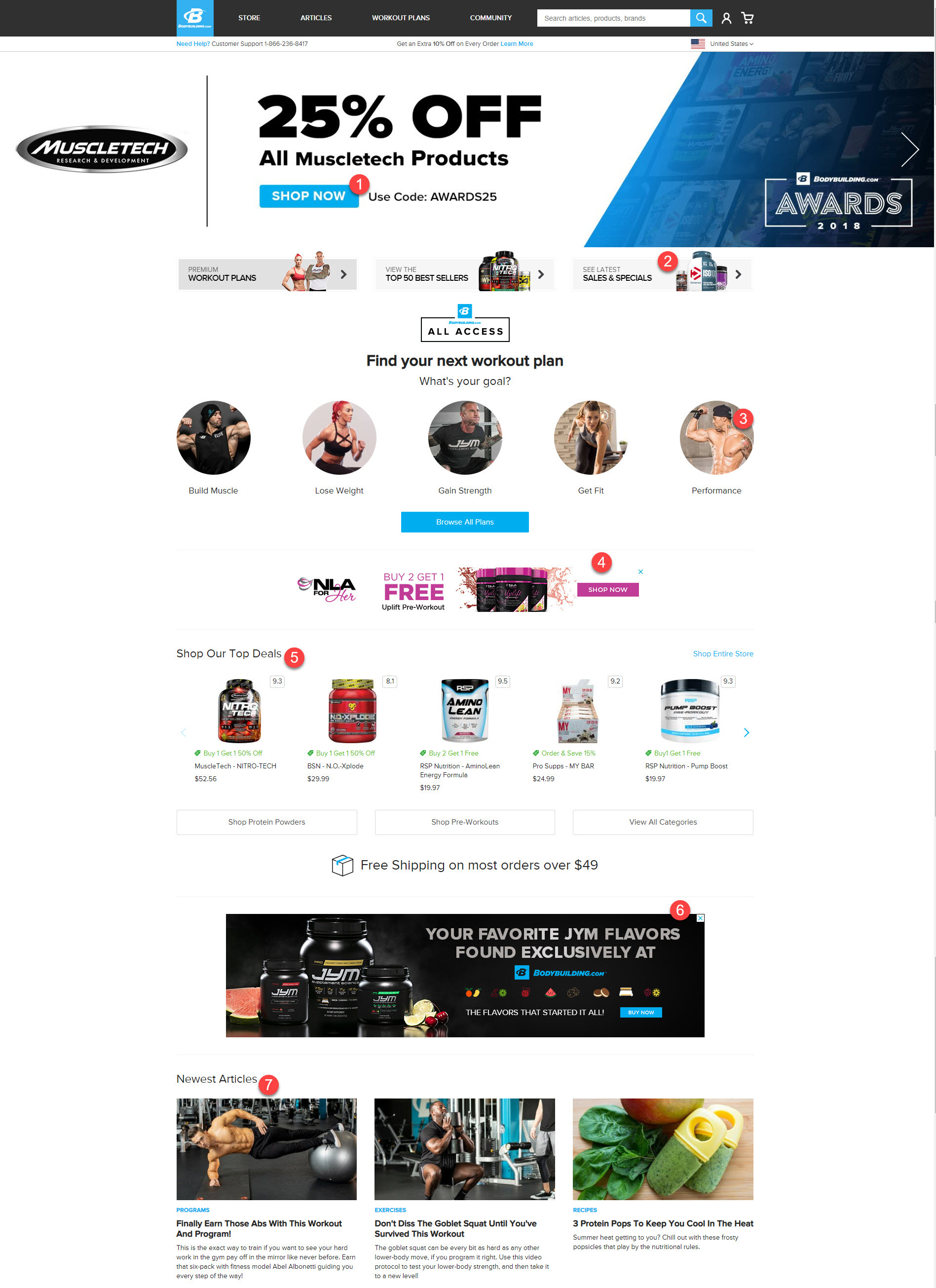
Let’s break the order of items on the page down:
1) A gigantic carousel offering discounts on fitness products and plans, all of which include not only a steep discount but a button to begin shopping.
2) Buttons offering you anything from “premium workout plans” to the latest specials.
3) Images of muscular folk aligned to different workout plans. Clicking one of these allows you to make a purchase.
4) A small banner selling a “health supplement” (I honestly don’t know what else to call it) which you order right on the site.
5) An opportunity to shop for the sites best deals
6) A large banner selling a “health supplement.”
7) A banner ad selling the site’s own products.
8) Health-related articles, i.e., “helpful” content.
In other words, it’s only after 7 commerce related page elements that we get to the site’s informational content.
Look however at how the site primarily describes themselves:
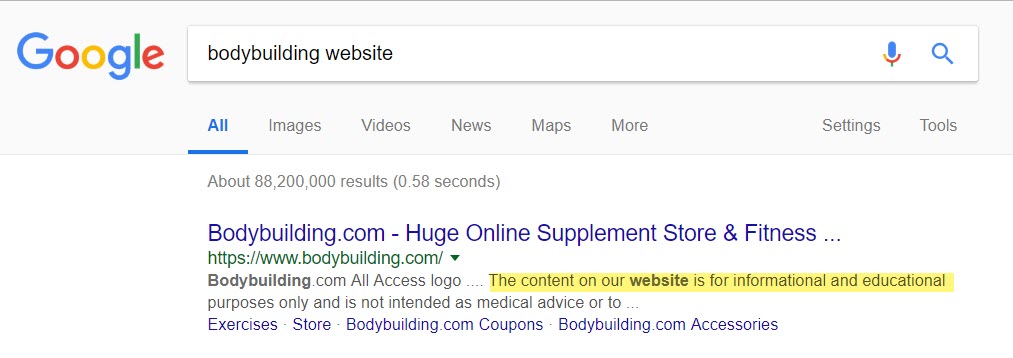
If it’s only after 7 major e-commerce elements that we get to any sort of informational content, what’s Google supposed to think? It seems clear, when looking solely at the structure of the page, that the site really aims at selling products and services, and not at offering content. From an E-A-T (Expertise, Authoritativeness, Trustworthiness) perspective, what is Google supposed to do here? How can the site’s content be considered either of those three traits (particularly trustworthy) if the page is set up as such?
Again, I’m not saying the site is being dubious. That said, we should ask, why hasn’t Google demoted it earlier for the reasons I just presented? Aren’t there just too many ads? Hasn’t Google demoted sites with tons of ads? What’s different now? It would seem that what’s different is the ability to profile a site’s core intent and compare it to their underlying and conflicting profiles is a new algorithmic ability.
Site #3: draxe.com
I started to break this site down as part of my recent post surveying the aftermath of the August update. At first glance, I could not figure out why this site was hit so hard (the update saw it lose 65% of its organic visibility). The homepage contains an obviously placed shopping tab, which is fine (because I am NOT saying that you can’t mix content and commerce, that’s not the point). However, after clicking on a few articles something began to stand out… a lot of ads pushing the site’s own product… a lot!
The inner-page experience includes multiple side ads showcasing anything from protein powders to health training courses:
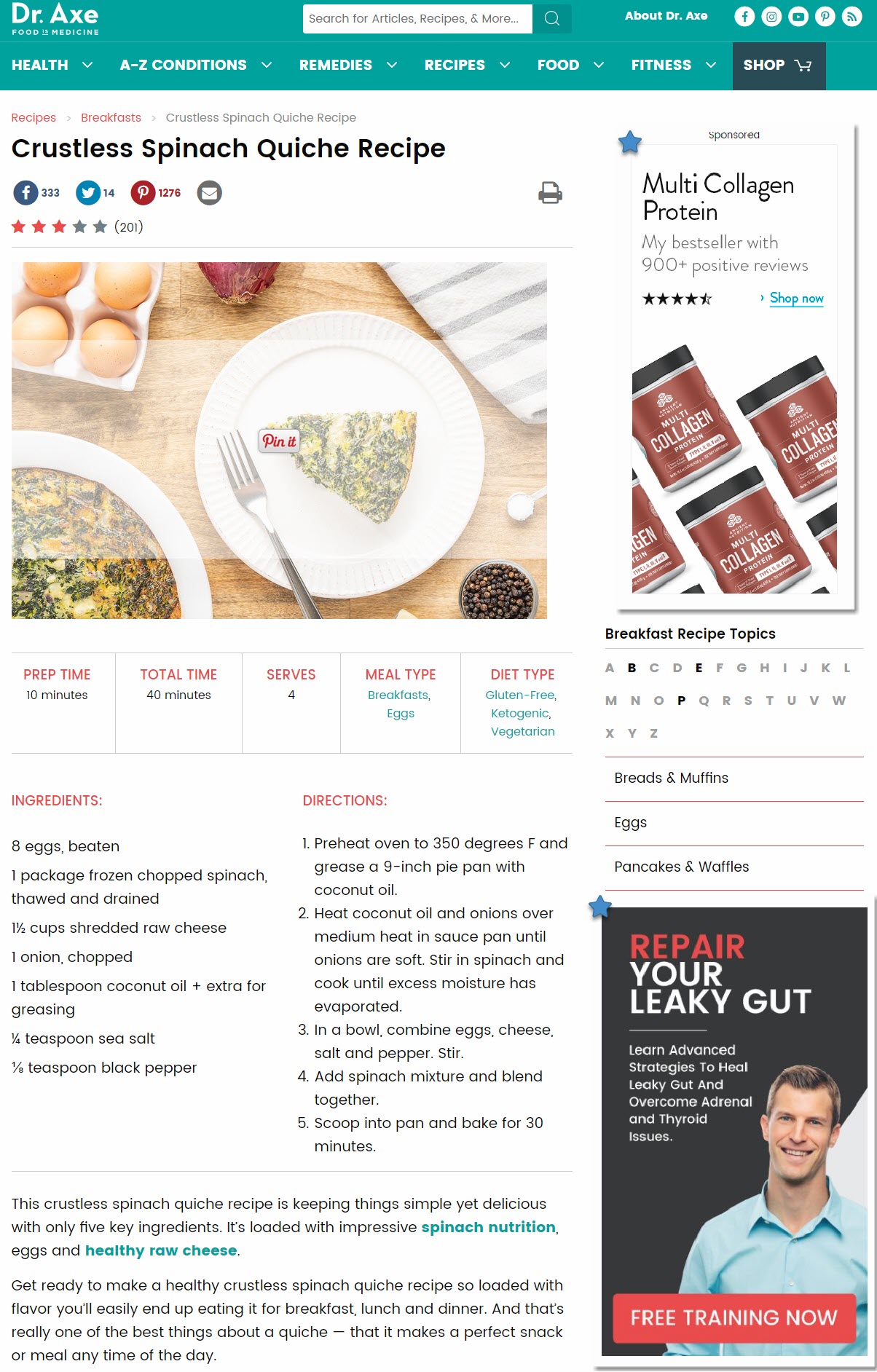
In addition to that the site shows an ad pushing its product and services at the bottom of the page as well:
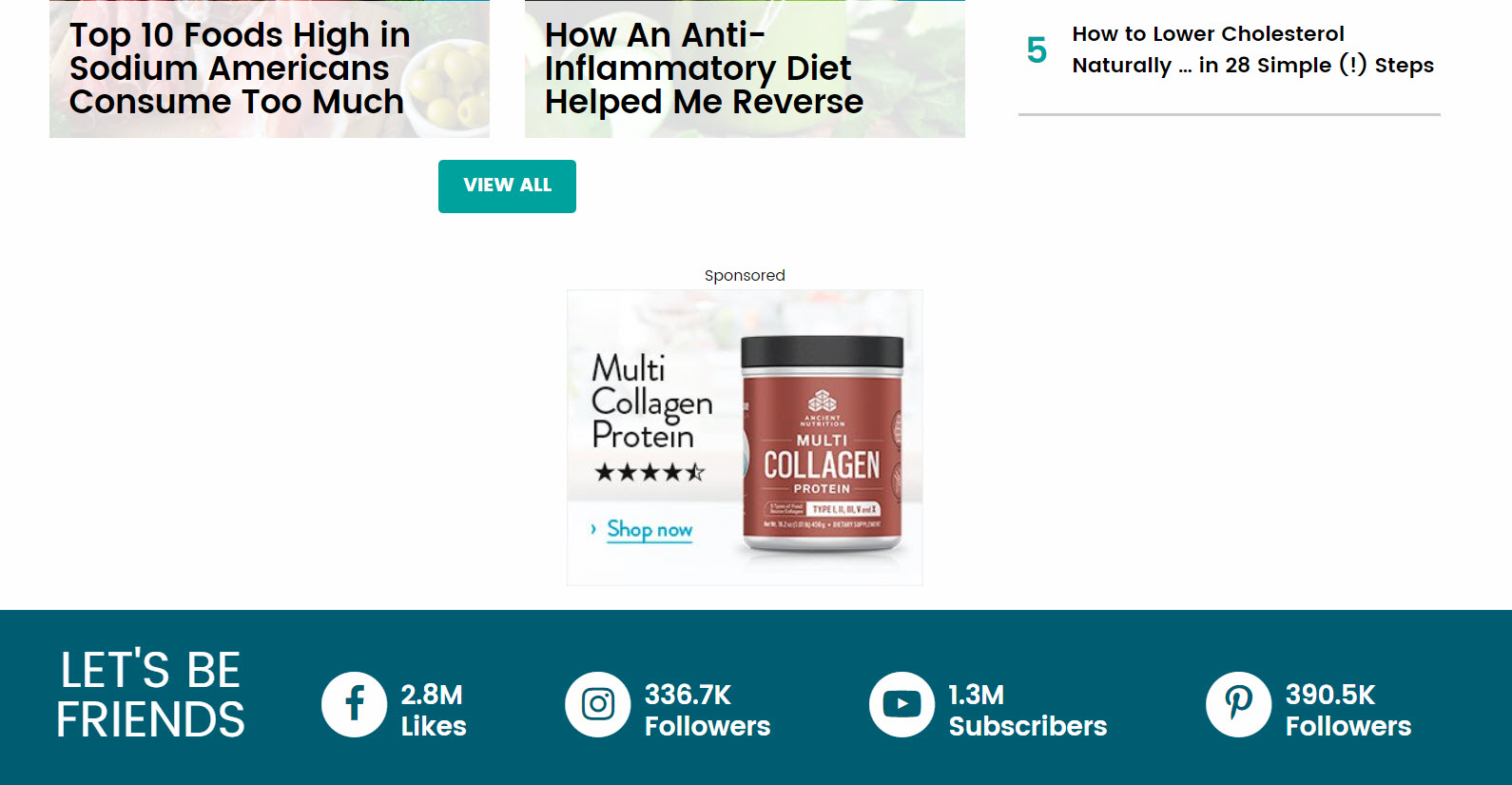
More, the site employs interstitials to promote its products and services:
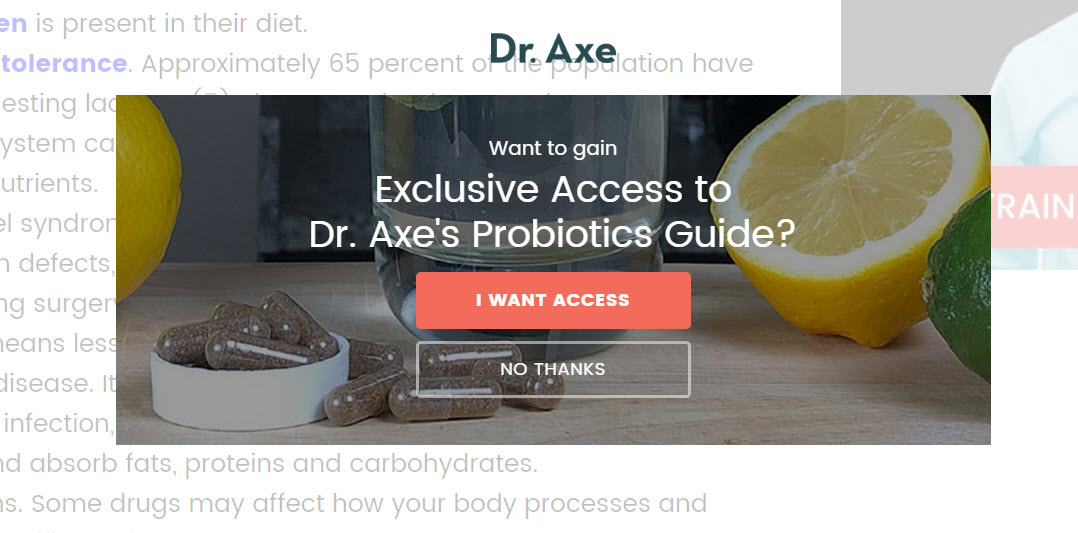
As well as banner pop-ups:
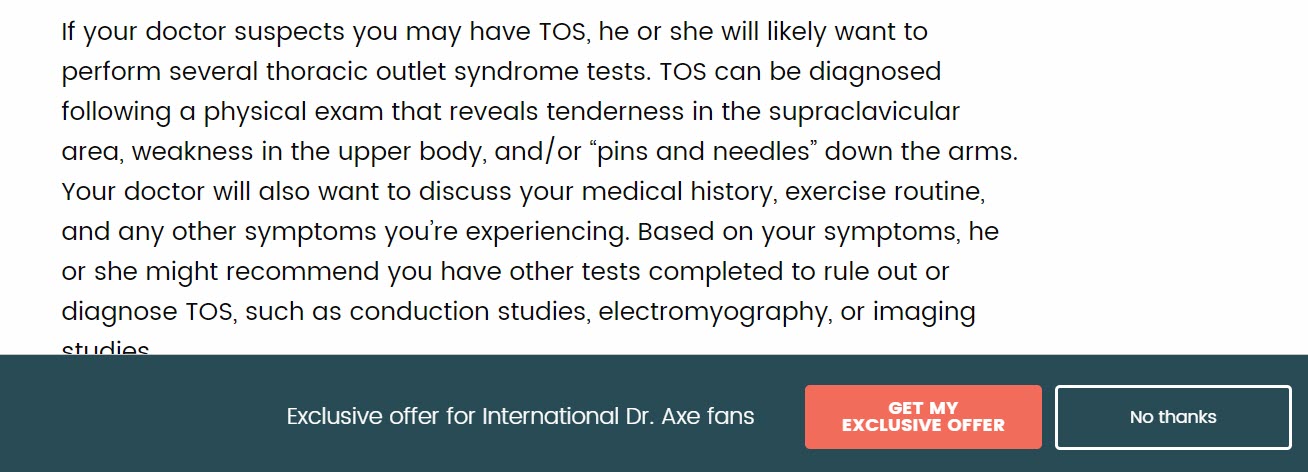
Let me ask, is this site about offering you great content related to nutrition or about selling you health products and services?
Well, what does the site say?
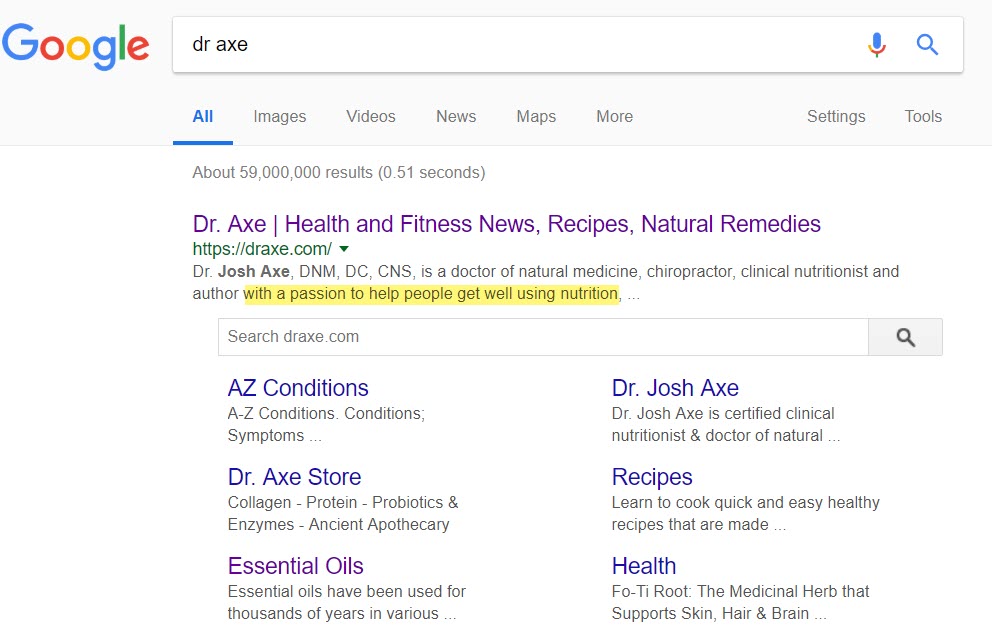
The problem is obvious. The site is portraying itself as an informative site, it works hard to create that profile for itself via its content heavy homepage. It also works equally hard to avoid coming off as a commerce site on its homepage. It’s sort of a “double whammy.” The site already has created two separate identities, two distinct profiles that are not intertwined in any substantial way. This is problem #1. A separate and seemingly distinct profile that does not align or work with the site’s core intent/profile.
The second issue is that by completely dedicating its homepage to content, and by pursuing sales in an almost backhanded manner, the site raises (whether legitimately or not), “trustworthiness” red flags. That is, is a site “safe,” is it 100% dedicated to helping users and protecting them from harm (something quite important for YMYL sites)? In other words, according to what I’m saying, Google can not only pick up on the second site
A site that is clearly intended to sell a product or service, and perhaps uses content to help bolster that goal does not fall into this “trap.” I’m putting words in Google’s mouth here, but if the user is well aware of what the site intends to do, there is less concern about the nature of its practice being at **** with user safety.
The Site’s Lack of Authorship
There is another aspect of the site I want to discuss briefly and that’s a lack of authorship. I didn’t catch this the first time I analyzed the site, but very few of the articles have an author. As opposed to livestrong.com or even bodybuilding.com, which do have authors listed for every article, draxe.com did not. I very much believe that authorship, as also expressed in the recent update to the Search Quality Rater Guidelines, has emerged as an important part of the site profiling process now undertaken by Google’s algorithm. Again, particularly pertinent for YMYL sites, knowing who the author
It’s a pretty intuitive concept… if Mick Jagger is writing content for your site, your site probably deals with either music or **** use. At the same time, not having an author leaves a gap in the profiling process. But I speculate that it’s far worse than that. Let’s ask: Why would a site not list the author? While logical in some instances, that very question again raises red flags for the search engine as it points towards the potential for dubious behavior in certain contexts and in light of other site qualities (as have already been enumerated).
#4: spine-health.com
With a 31% visibility loss, spine-health.com was yet another health information site to take a significant rank hit during the update. At first glance, you would not understand why this site was hit. Sure, the inner pages contain a good deal of ads, but is that enough to be hit and if so why now? In fact, many of the articles are written by genuine health professionals (i.e., MDs, PTs, etc.) So why the demotion?
Well, all you have to do is scroll down the homepage:
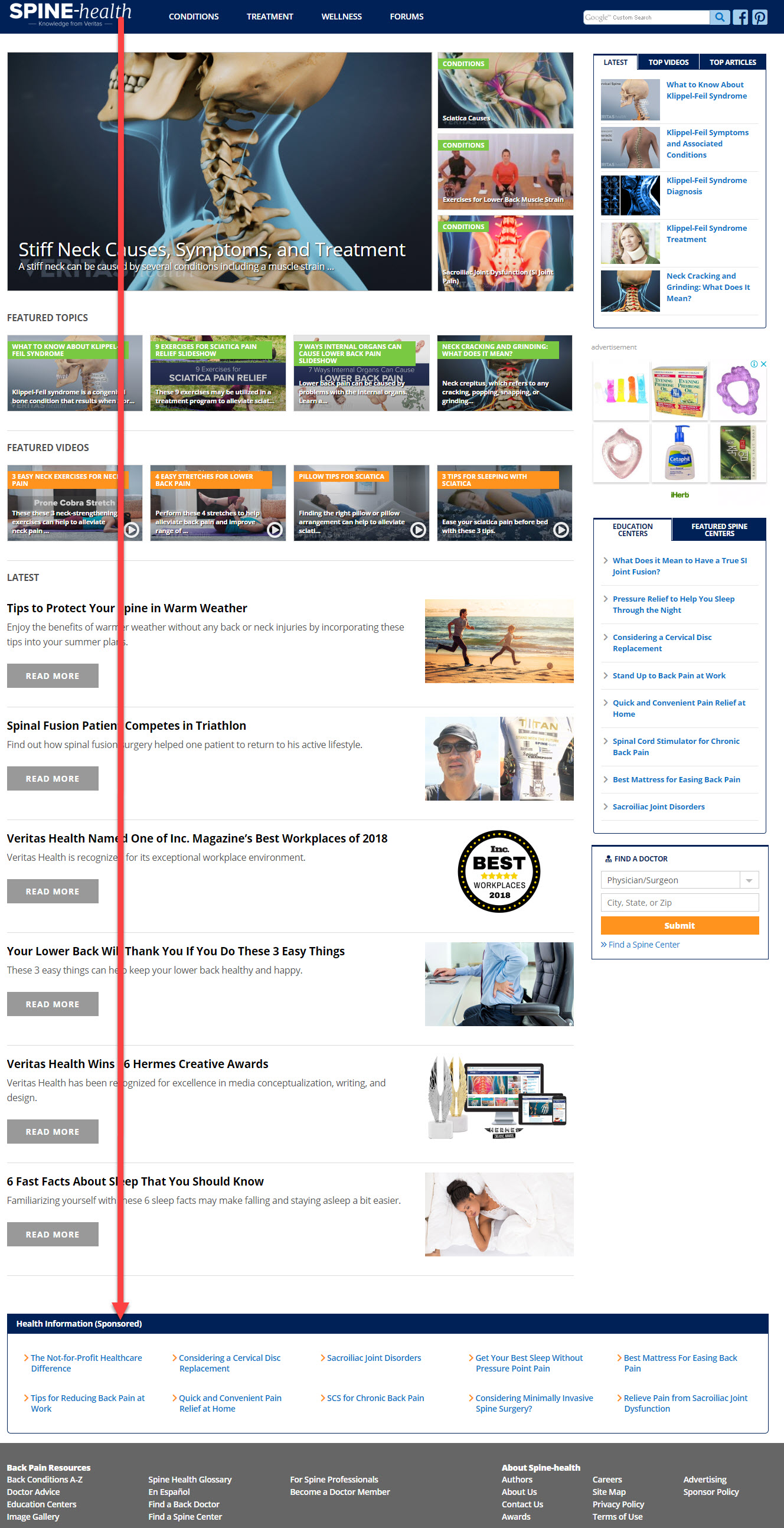
After showing a nice amount of pretty substantial content the site does the unfathomable and offers a large set of sponsored content. Does the site vouch for this content? Has it been checked to ensure it’s safe for users to consume?
One could argue, that the user knows this is sponsored content and can make their own decision to access it. That’s a good argument outside of the YMYL universe. Here, the site has a responsibility to ensure the user has a “safe” experience, part of which includes pointing the user towards safe content. Unvouched for sponsored content is not a safe practice. This is a clear example of a YMYL site calling into question how trustworthy it really is.
But it’s really much worse than that, this sponsored box appears on pretty much every page.
But it’s really much worse than even that, here’s what happens when you click on a sponsored link:
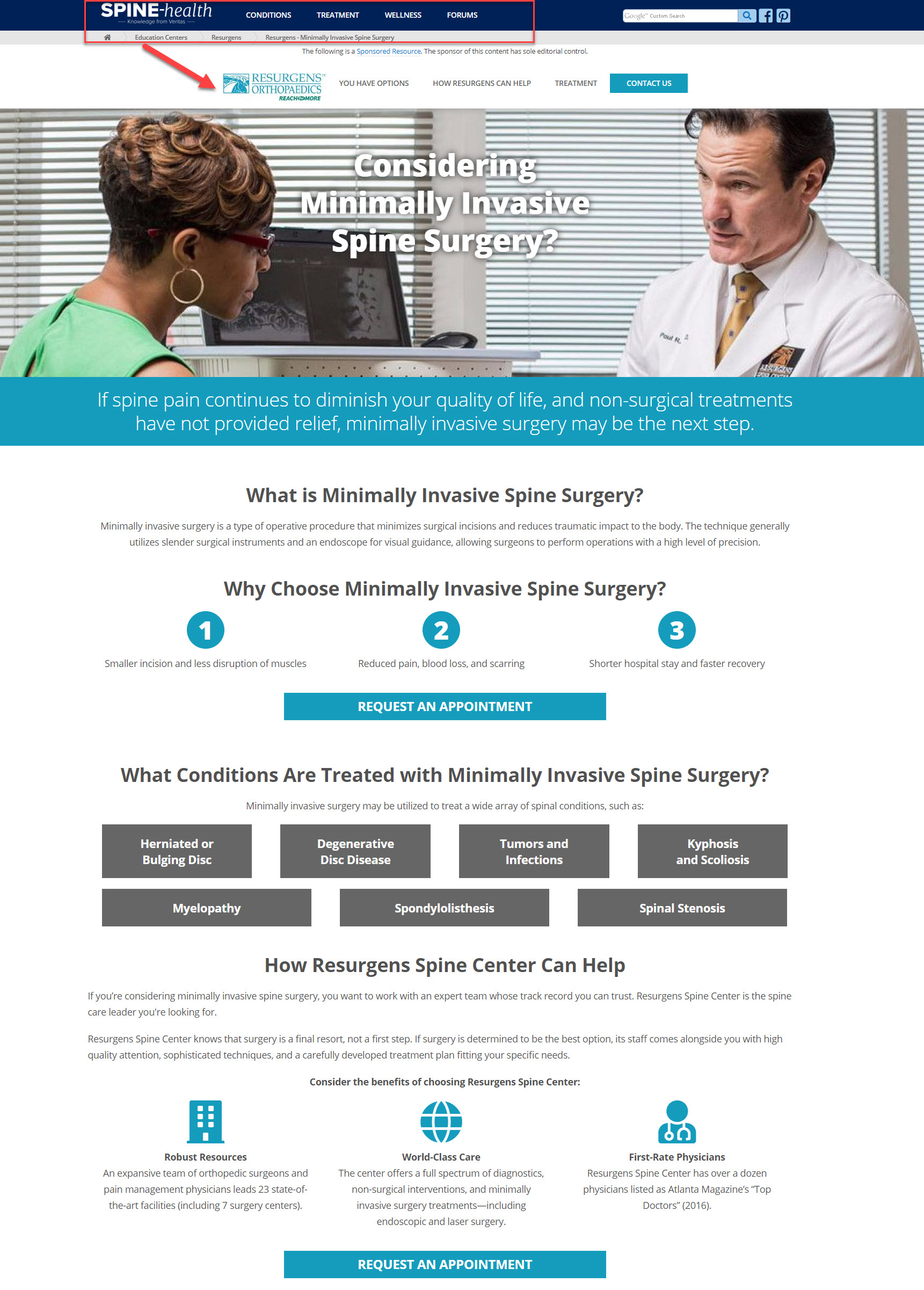
Not only is the site offering content that it has not vouched for, but it’s hosting it on its actual site! The site is offering the advertisers a page template (since all of the ads follow a very similar format and feel) and hosting the page right on its site. In other words, the site is in a
By the way… the above is an ad to have surgery done!
Again, it’s the same twofold problem: An overemphasis on commerce that creates a site profile in conflict with the core site profile and a giving off the appearance of using solid content to conceal its commerce aspirations (again, I am not saying the site is doing
There’s one last interesting thing about this site, it is part of a network of sites that includes arthritis-health.com, sports-health.com, pain-health.com. etc., which are all “visibility challenged.” These sites all fall under veritashealth.com.
I’ve seen similar ranking losses for other sites that operate as such. For example, verywellfit.com lost 30% of its visibility. It too has sister sites such as verywellhealth.com, which also suffered losses. These sites all fall under verywell.com. I wonder if this construct presents a problematic paradigm. Please understand, what I just said is quite anecdotal, and requires further investigation.
#5: thesimpledollar.com
Let’s see how some the site dynamics discussed above play themselves out for a finance site. Financial information and advice site, thesimpledollar.com lost a whopping 65% of its visibility in early August. Like some of the other sites I’ve thus far discussed, a first look at the homepage would indicate everything is copacetic. It’s not until you scroll down towards the bottom of the page and reach the ‘Credit Cards’ section. Clicking here brings us to an article entitled Best Credit Cards for 2018. Seems fine, that is until you read the Advertiser Disclosure:
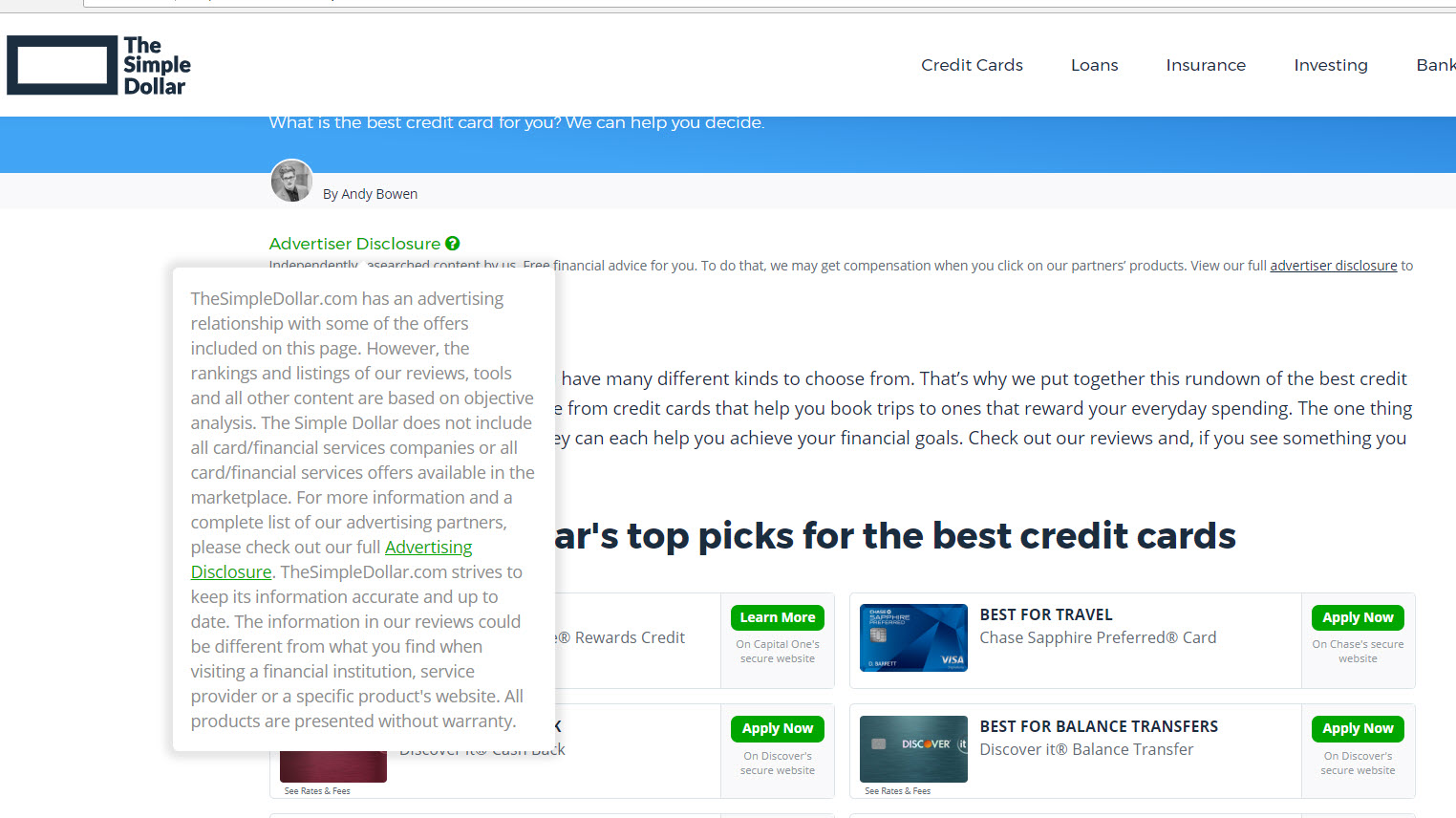
It is entirely possible that this statement and the disclosure linked to within it are entirely accurate. I am certainly not accusing the site of mispractice. More, many such sites act accordingly. Surely, they did not all lose their ranking success?
Let’s get into this a little more so that we can see why a second profile may have been noticed by Google.
First, look at how large the ‘Credit Card’ element is:
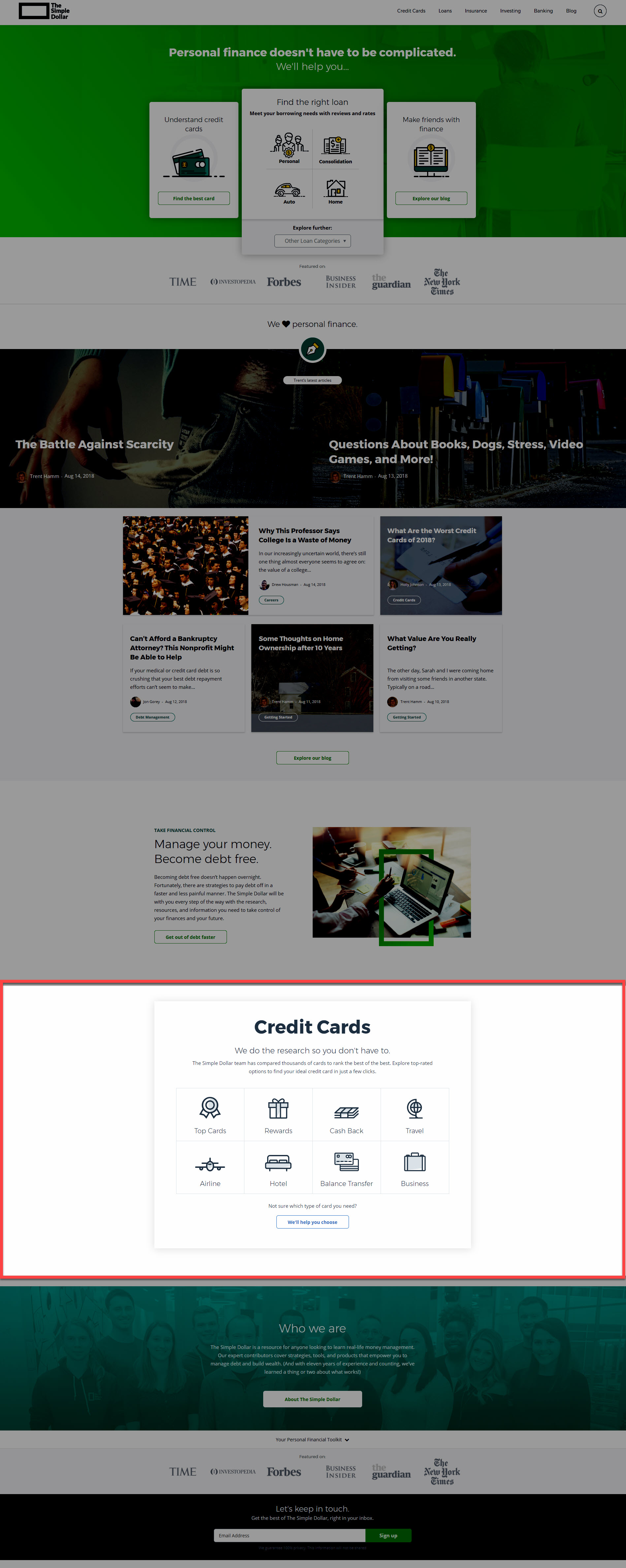
Next, consider, the site offers other sorts of comparisons. Take car insurance, there is a nice article on the best policies you can buy, but does it appear on the homepage? No.
Let’s actually look at the comparative page for insurance:

Nothing on this page looks too out of the ordinary.
Now look at the page in comparison to the second half of the page that discusses different credit cards:
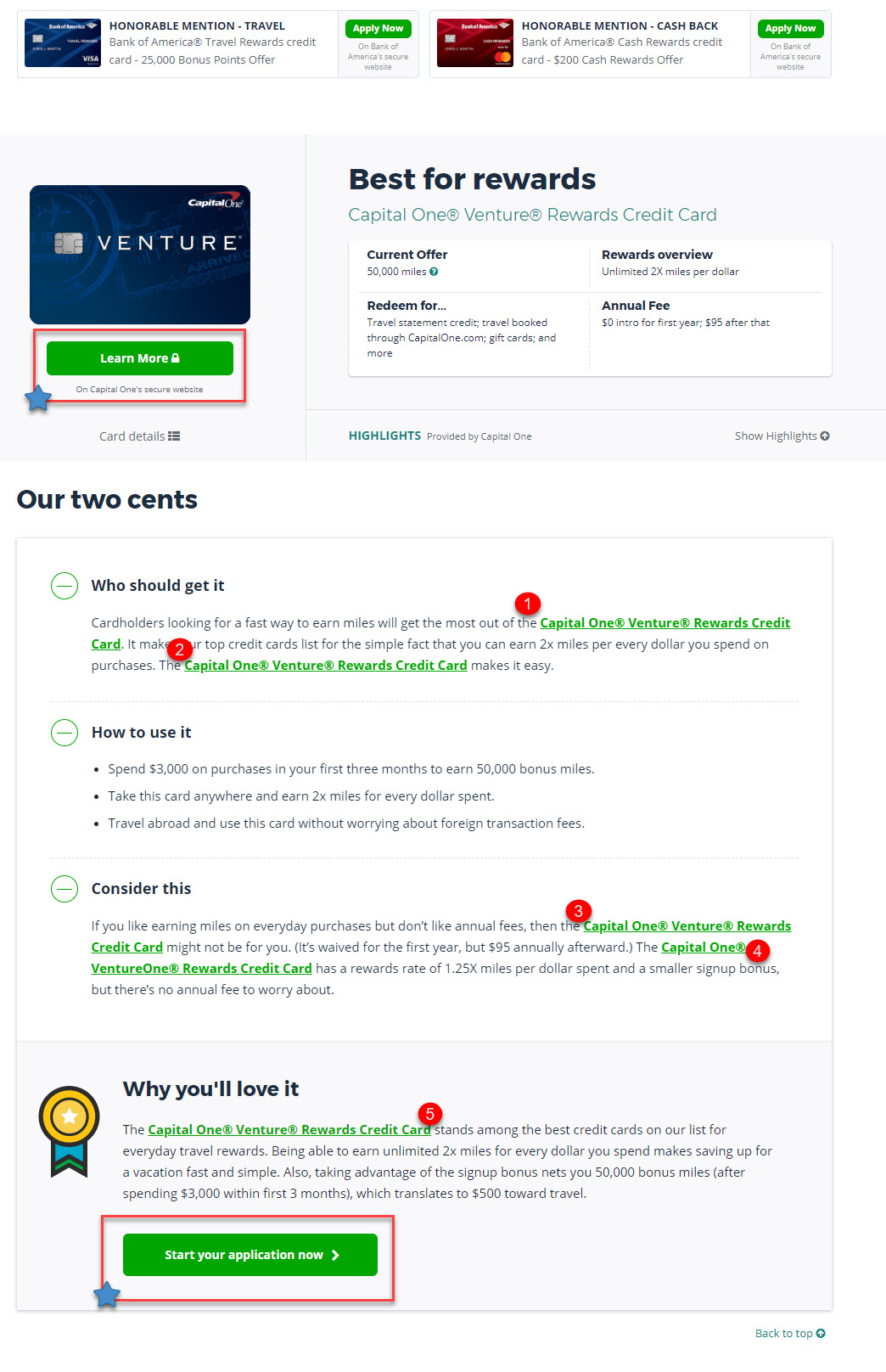
Here, as opposed to the insurance page, the site is pushing you to the credit card company’s site via a very visible ‘Learn More’ button that is accompanied by a plethora of links to the card – too many to be honest. You even have a button prompting you to start an application. Why? I thought this was just an informative page (where I could understand having a link makes sense)? What is this page trying to do (hence the profile problem)?
You might ask, but didn’t the site also link to insurance company sites as well? Nope. They did worse. Watch:
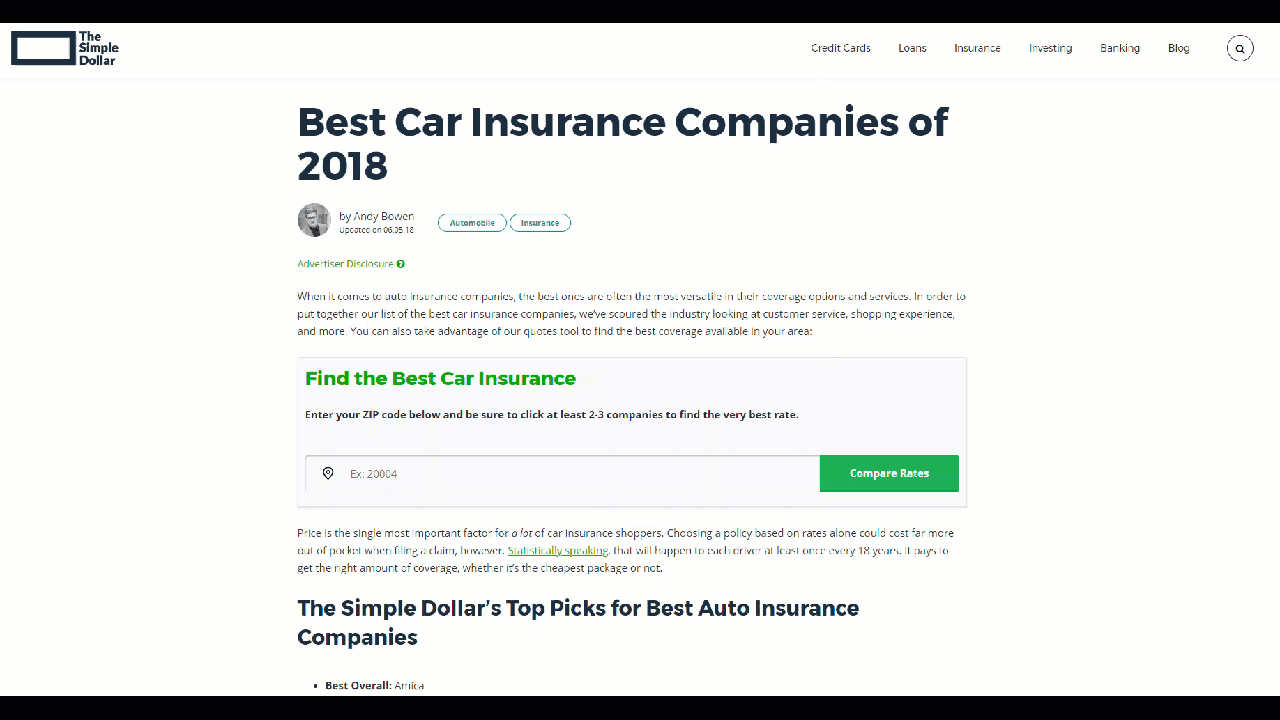
In this instance, the link for the anchor text ‘State Farm’ brought me to a search box where I could compare the best insurance rates. It’s the very same search box that was also shown at the top of the insurance page. I must ask, did the site put that very search box at the top of the article to help users find insurance or as a gateway to sponsored sites? Again, the actual answer does not matter so much as Google having the question does.
Not only
Let’s then ask, are there no links on the insurance page because such links are only relevant for credit cards or because State Farm didn’t agree to a financial partnership? You get it, the answer doesn’t matter for our purposes, but the question is striking.
For this site, I think conflicting profiles that raise user safety concerns is a pretty solid reason why they lost 65% of their organic visibility.
Content Not Aligned to Core Site Intent Impacts Rank
Until now I’ve shown instances where an underlying and less overt e-commerce profile has negatively impacted rank as a result of the Google Update of early August. There is though a simpler illustration of how Google’s suspected new site profiling algorithm has impacted sites. With Google profiling sites in all-new ways, having a considerable amount of content on your site that does not align to its core intent/profile becomes problematic.
#6: valuepenguin.com
The first thing to note about this site is that it has a very similar problem to that shown for simpledollar.com. It is most likely a big part of why valuepenguin.com lost 23% of the visibility it had prior to the August update.
Have a look at their insurance page:
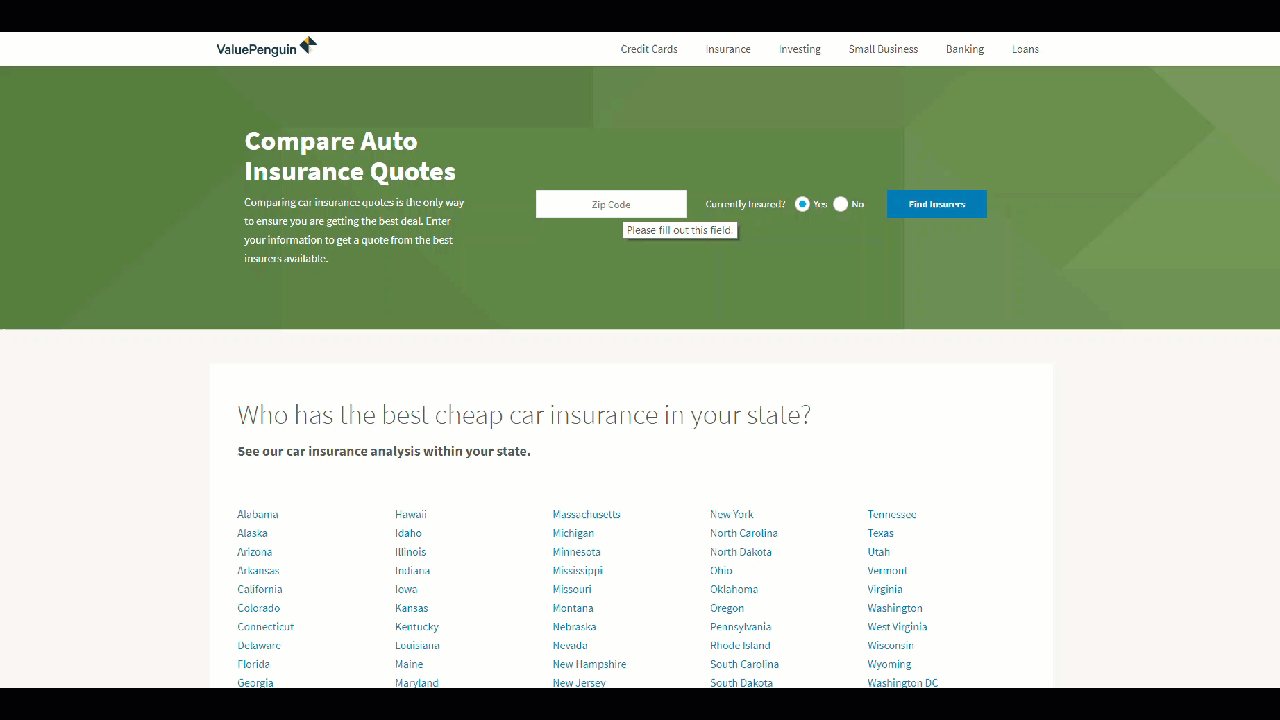
Looks pretty similar to what we had with the
What’s really interesting is that in this case the site fully discloses that sponsorship will impact the order of the results shown (though not which results appear altogether):
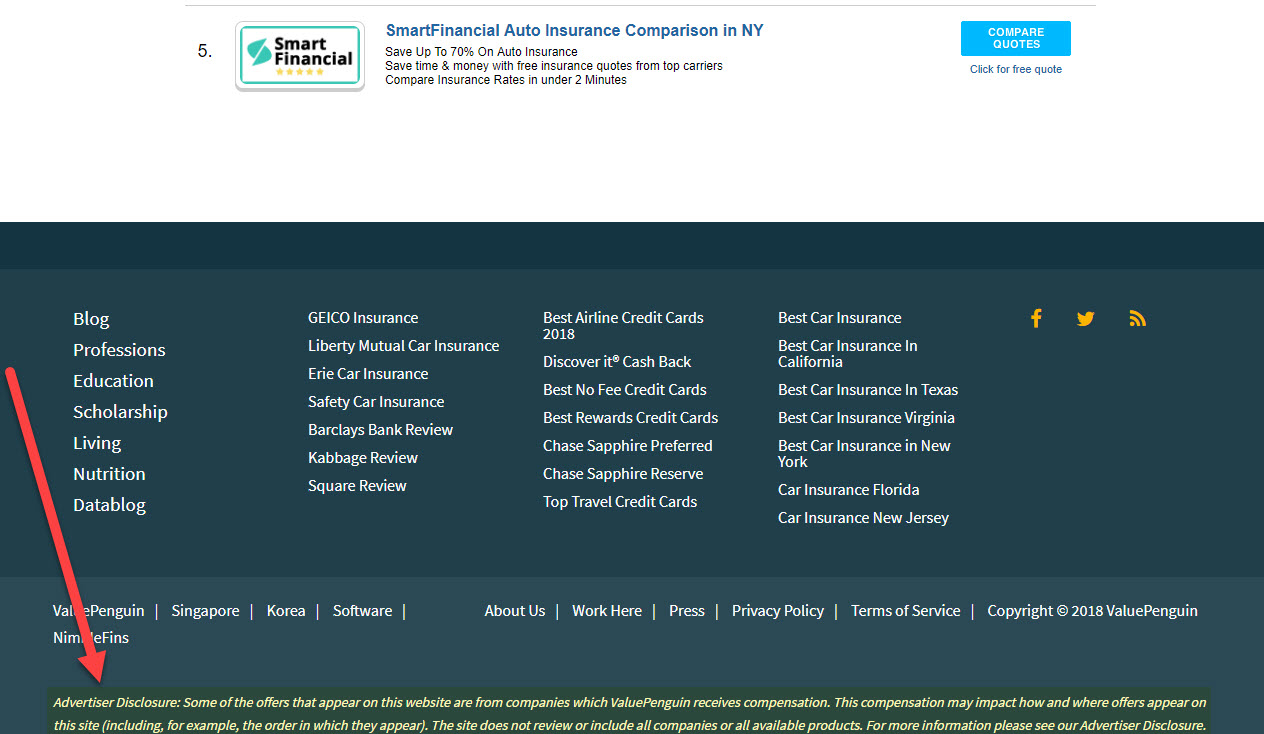
I’m not sure if this is better or worse in general, but from a site profile perspective, it might be worse. The site is essentially telling Google that user “safety” is not the prime concern.
So again, we have a competing site profile that questions the E-A-T elements of the site.
Yet, this YMYL site has another problem. For this, we need to head back to the site’s homepage. Nothing immediately striking here (yet again). The site offers easy access to its analysis of anything from credit cards to banks to insurance. Basically, the site presents access to analysis of the major facets of your financial life… and then offers you an article on saving money on disposable diapers:
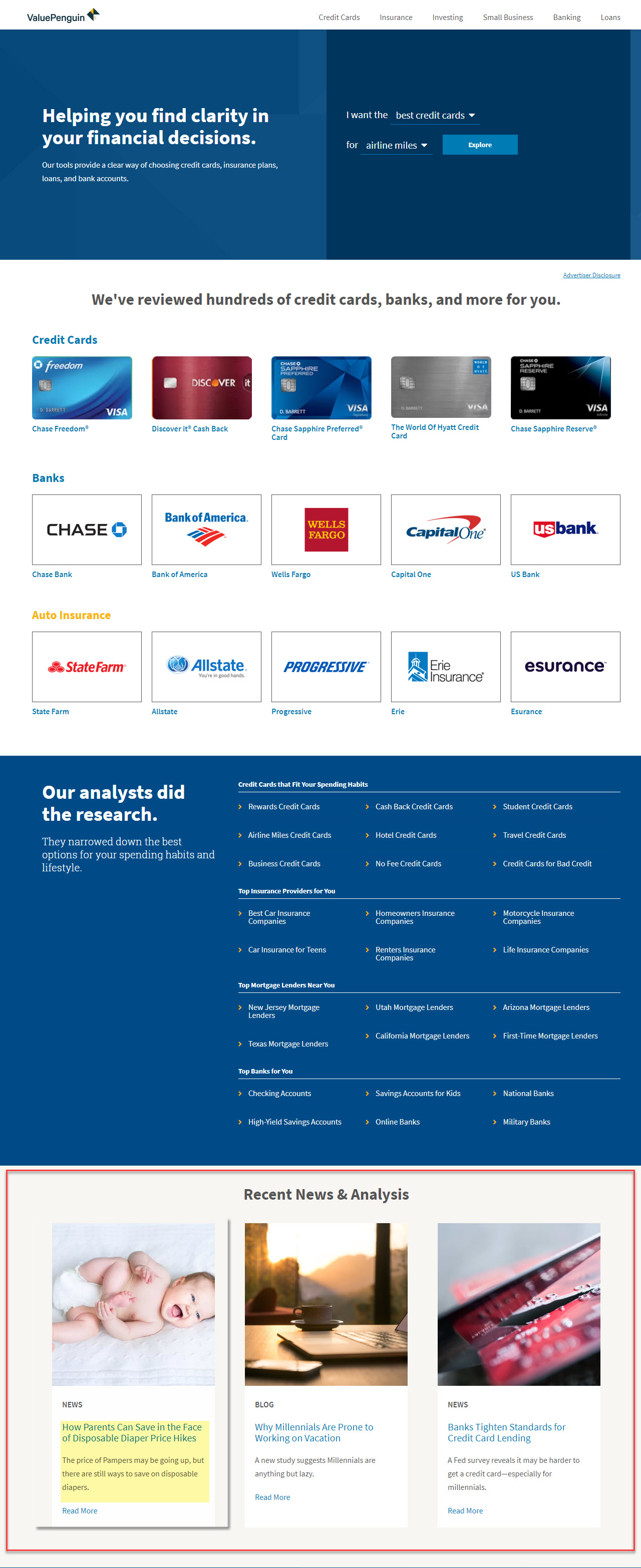
Of the three articles shown,
Of the 12 articles shown on the first page of the site’s blog, eight do not align to the site’s core profile:
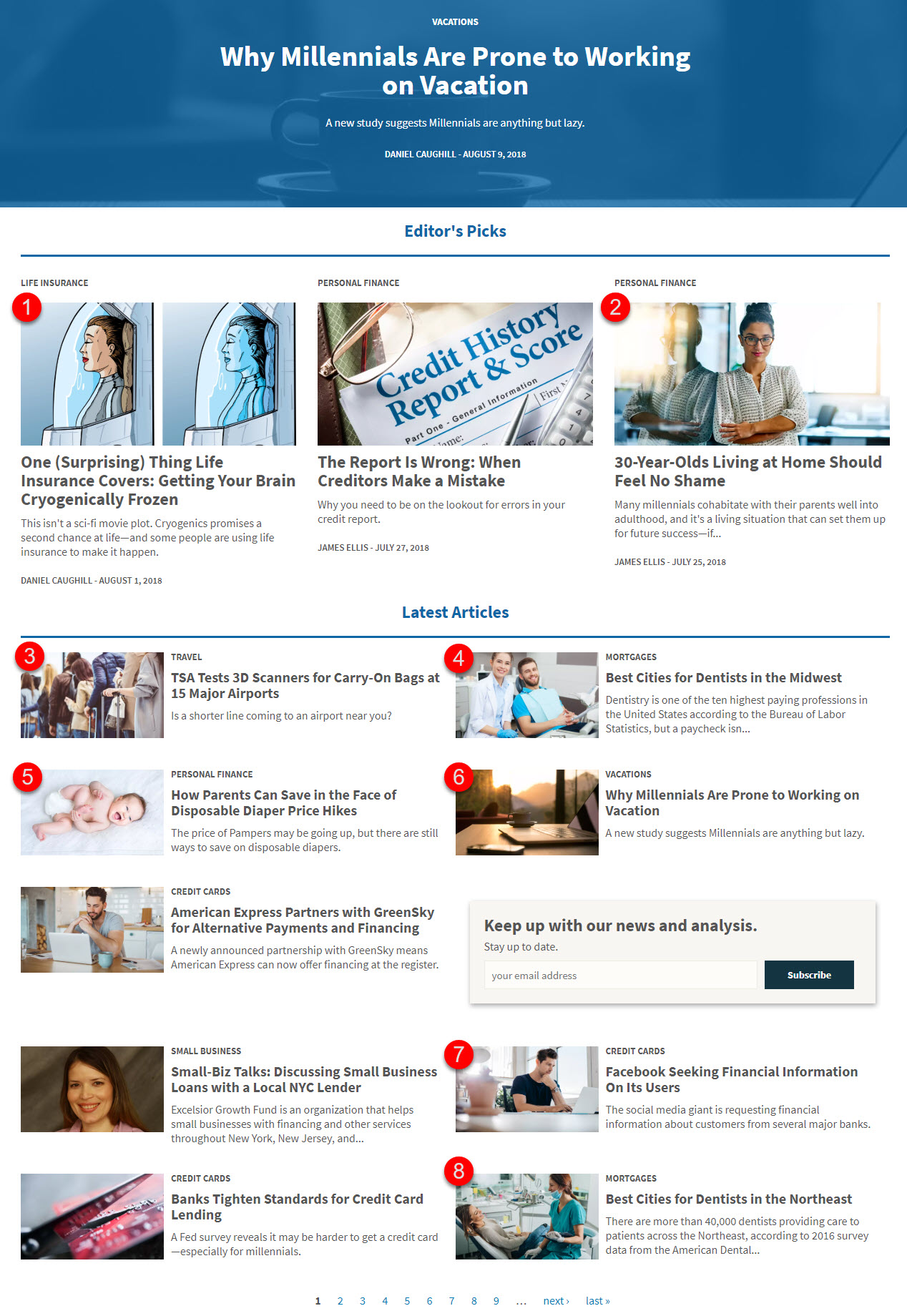
The titles of the majority of the content on this page are only loosely connected with the site’s core intent profile. Sure, the site most definitely deals with insurance plans, but is a life insurance plan covering your cryogenically frozen brain of the same financial practicality as a post on dealing with errors on a credit report? Which of the first two posts better aligns
Here, the case for saying that Google profiled the site, looked at its content and saw a discrepancy is pretty solid. It would appear, that the site is pushing content for whatever reason (to rank for more keywords perhaps) that does not align to its core site profile, to what the site actually intends to do.
In other words, is this site about serious and substantial personal finance analysis or is it about offering light and perhaps fringe financial content? The profile discrepancy could very well help to explain why this site lost so much as a result of the last update.
#7: health.com
Sites like these have always personally confused me, but now many of them have lost some significant visibility with Google’s August update. The site health.com lost 18% of its organic visibility in early August. Perhaps it’s because Google is now confused by what has been bothering me for years… are these kinds of sites health or celebrity sites?
When I was researching this site, on August 15th, 2018, about 20% of the articles on the homepage had to do with celebrities. Just compare the subject matter from these two articles:
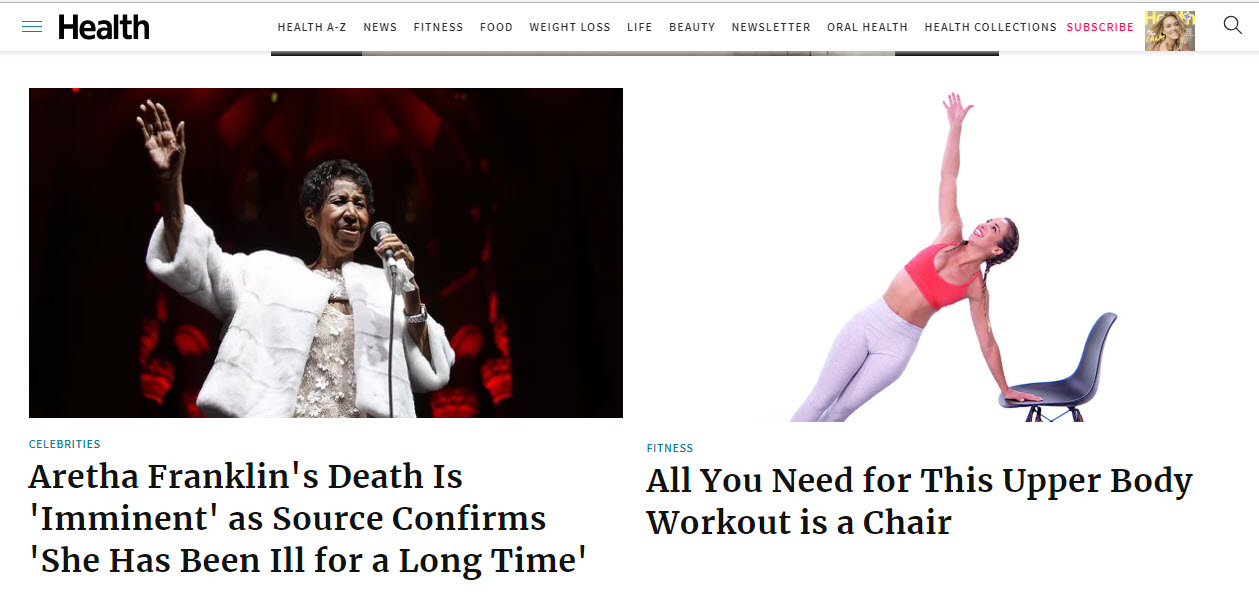
I don’t know how to phrase this other than, what does Aretha Franklin’s imminent death have to do with health information? Is this a health magazine or tabloid? I don’t mean that in an insulting way. If the site is a tabloid site, so be it, but then it should post content aligned to that profile. It should also describe itself as such, which it does not:
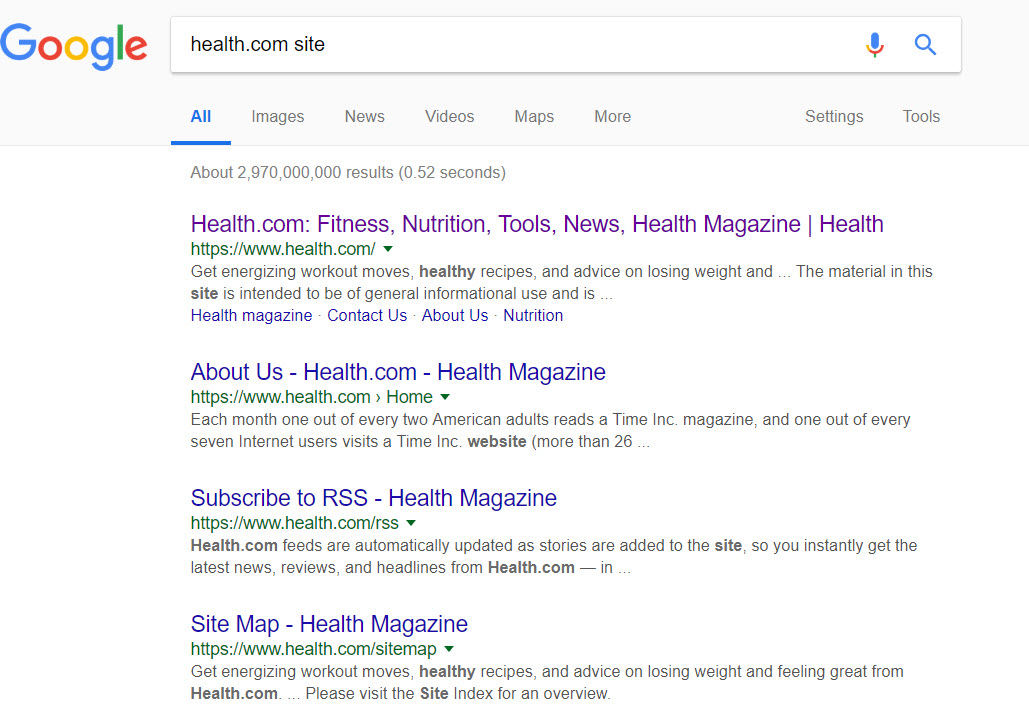
Leaving the tabloids aside, and considering that the site profiles itself as one where readers can learn how to better exercise, eat, and lose weight, the content is too sensationalized in my opinion for Google to consider them as such.
The problem is, the site goes in too many directions. In this sample of its homepage, one article needlessly (from a health perspective) brings in a celebrity, two are sensational stories that relate in a way to health, and one is a real article that offers exercise tips:
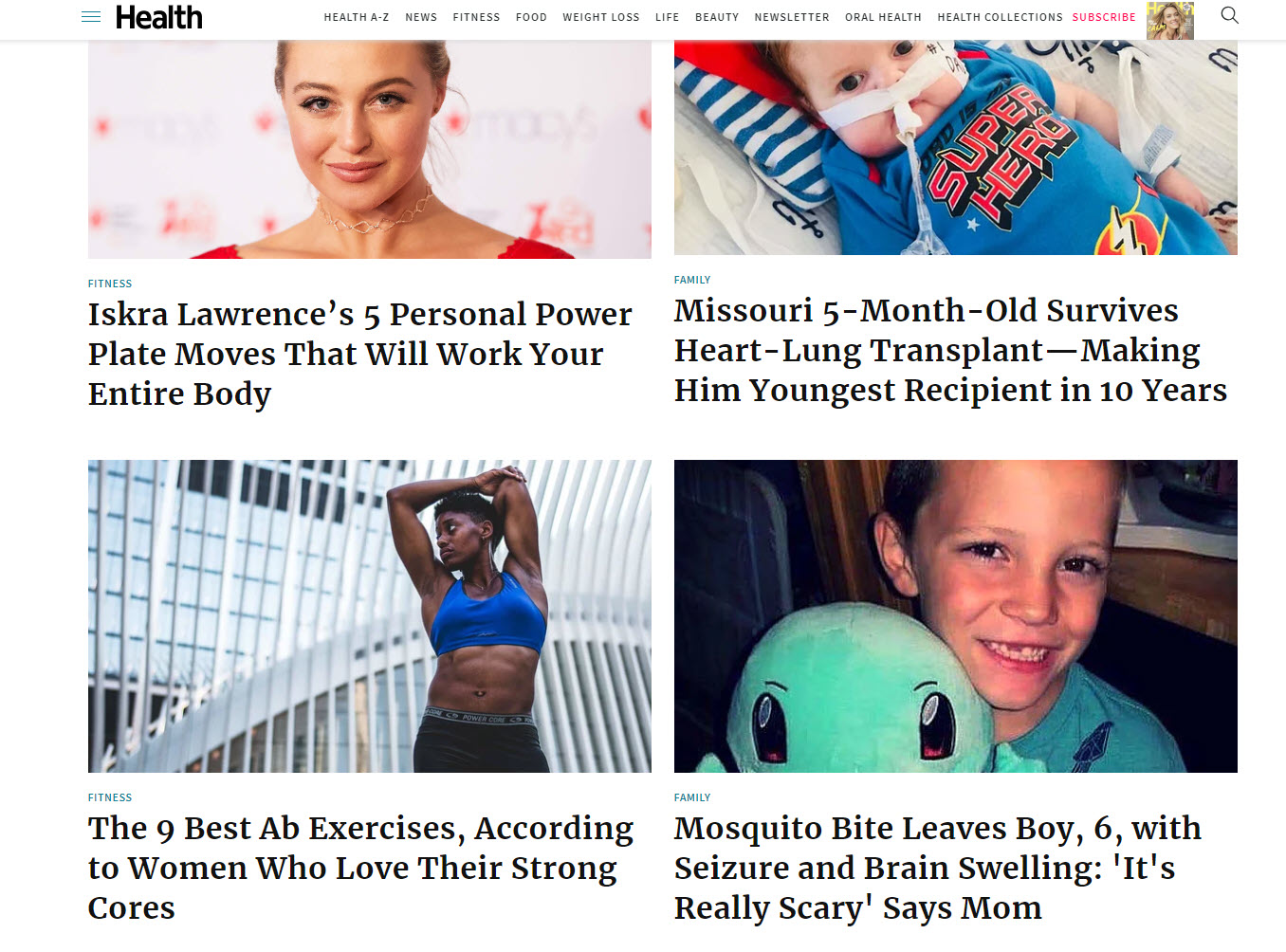
In a day and age where Google is getting increasingly better at understanding content and why a user would read it, this spattering of topic matter just doesn’t work. It’s hard to consider this a serious health site, which is what the site wants for itself (it is called health.com
What’s interesting here, and perhaps indicative of a new profiling element within the algorithm, is that this
What this means is that you don’t have to have a competing site profile in type (i.e., commerce vs. information), but one that is inconsistent within the same vertical. Thus, the days of posting content for the sake of posting content are no longer. Content should be related to your core profile, it should be aligned
Look at the menu for the site health.com, does it align
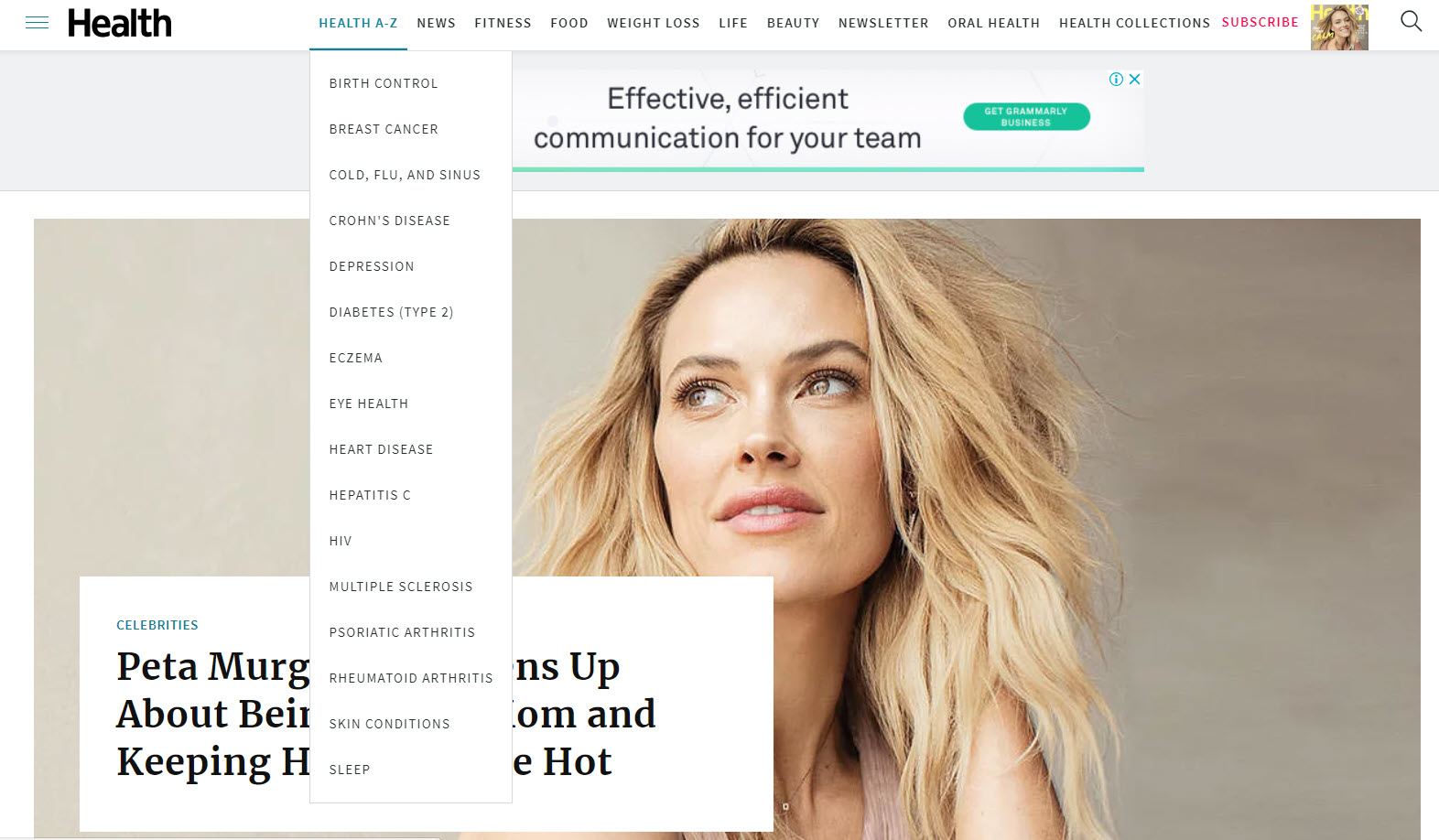
#8: medicalnewstoday.com
Nope, this site did not get hit by the last update. Instead, I want to show what a “top” site in this new profiling environment looks like. The August 2018 update boosted the organic visibility for medicalnewstoday.com by 20%. Let’s look at what’s perhaps part of the reason why Google did as such.
Looking at this site, particularly in comparison to some of the other sites shown here, and one thing really stood out to me. The authorship of their articles:
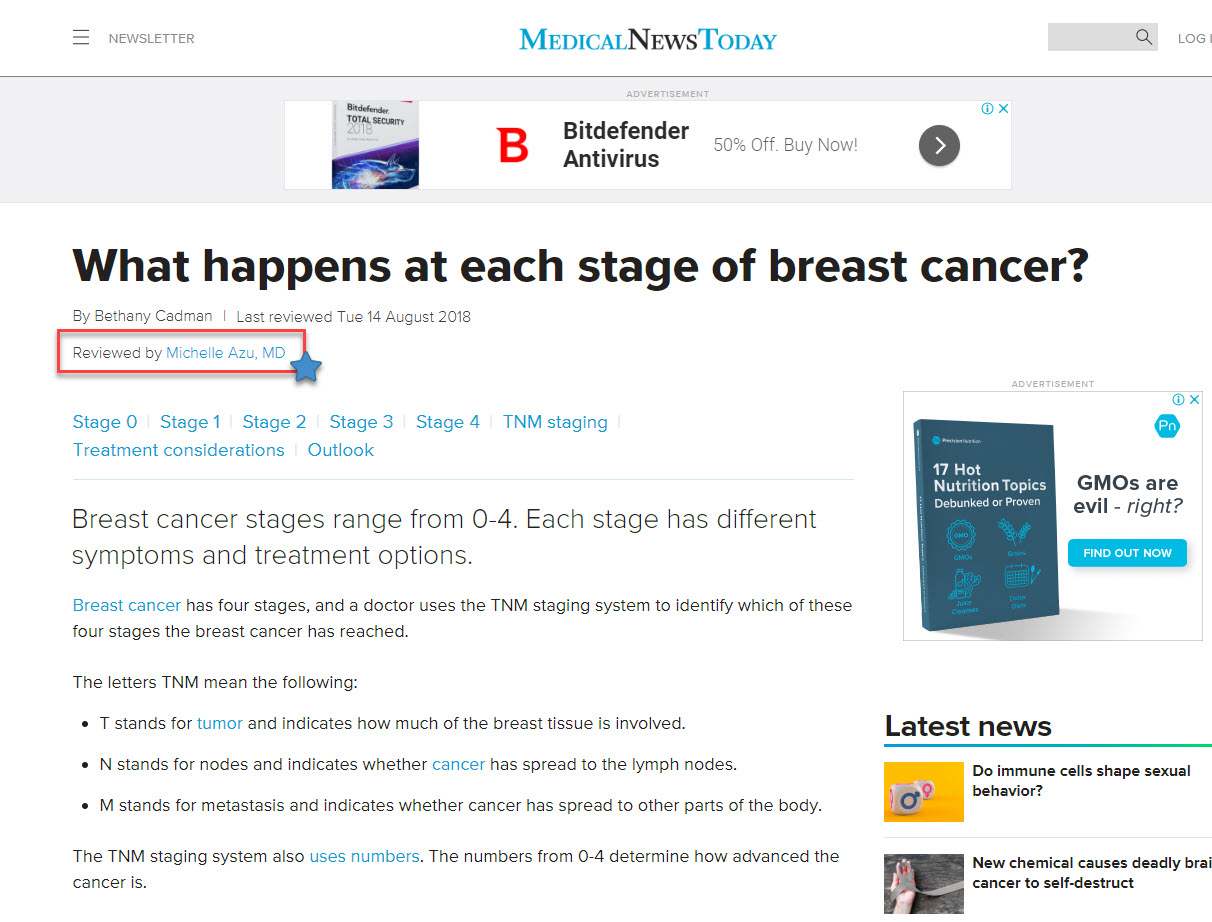
In general, the articles are fact-checked, often by licensed healthcare professionals!
Now let’s jump back to the homepage:
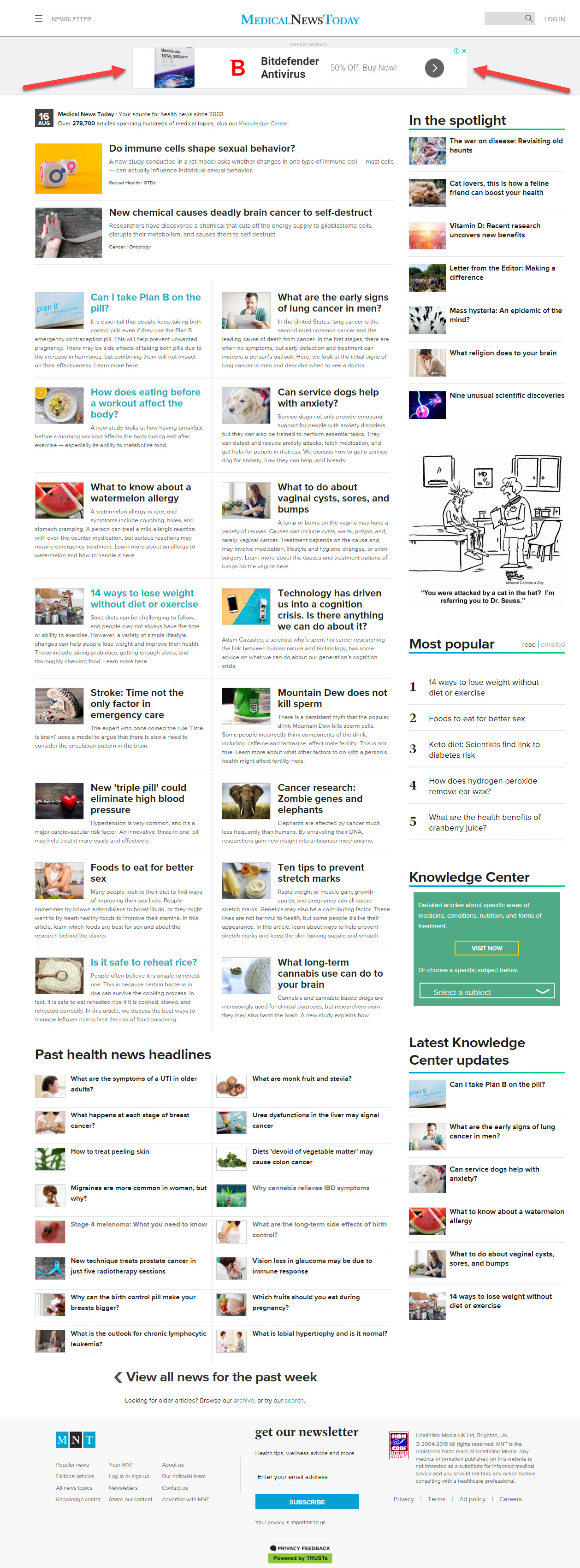
Just one relatively small banner ad, that’s it. Also, look at the articles, no filler here, just serious and substantial health information.
In short, the site strictly adheres to its core profile, does not offer an ad-heavy experience, and presents super authoritative content. The site is the definition of E-A-T, is certainly safe, and has a vivid site profile. No wonder the update rewarded it.
YMYL, E-A-T, & Google’s Search Quality Rater Guidelines: Why the August Update Points Towards Site Profiling

Context is everything and putting the August update and this notion of a “site profiling algorithm” into context is all about Google’s Search Quality Rater Guidelines. The more recent changes to the guidelines (Jennifer Slegg from The SEM Post has a truly wonderful write-up on the changes quality raters are expected to make) speaks volumes.
There are a few changes I want to focus on:
Beneficial Purpose and Main Purpose ContentThe new guidelines have a strong focus on a page having a “beneficial purpose.” The increase in the terminology all but demands raters recognize the reason for having a given page that meets a specific intent. Should a page lack this, raters are asked to give a low rating.
One of the other changes now tells raters to give a low rating should a page not have enough main content (as opposed to the old version which told raters that not enough main content was reason enough to give a low rating, i.e., they were allowed to give a low rating based on this, not that they necessarily should give a low rating).
The important thing here, for our purposes, is that this seems very much like asking raters to think in terms of intent, as purpose and intent are synonymous. Not only that, but a page not meeting its expected intent/purpose is more important than ever, and demands a low rating. In other words, the new guidelines put more emphasis on a site/page aligning to its core intent profile.
YMYL Safety
I’ve been throwing the word “safety” around a lot in this post. The reason is that the new guideline changes now say that YMYL sites impact the safety of its users.
This is significant in
In other words, Google is on the lookout for misleading (whether intentional or not, whether by ad placement or off-topic content, etc.) YMYL sites and is asking its raters to profile accordingly.
Author Reputation
This is perhaps one of the more discussed changes to the guidelines. In a nutshell, raters are now being asked to look beyond content per se, but also at who wrote the content. That is, is the author reputable, do they have expertise in the field, etc.
Simply, this points to Google wanting to take a more holistic approach to
Put another way, Google via its changes to authorship in the guidelines is making a very strong statement, though you need to read between the lines a bit to hear it
For our purposes here, I want to unequivocally state that what I’ve seen (via my analysis) is that Google notices when no author is present (and in certain cases, and when combined with other elements that point to a “poor profile,” this can impact rank). At the same time, I very much believe that Google can determine when author implementation adds an extra degree of site credibility, as was the case for Medicine News Today, where health professionals verified the content.
Deceptive Page Design
Google created a new guideline to deal with instances where the page design all but forces you to click on an ad or the like. The most common case is an ad on a mobile page placed too close to another button so that you accidentally tap on the ad. However, there is the possibility that it applies elsewhere and to less extreme instances, as I’ll discuss shortly.
Connecting the Dots – Why YMYL Sites Were Hit the Hardest During the Update

Let’s suppose that Google is not asking its raters to do what it can’t algorithmically. What if Google is offering guidance based on what it can now do?
Let’s look at how Google has behaved with this last update. Every niche and every position was impacted, but YMYL niches to a greater extent. Considering that Google now considers poor profile practice to be bad for the user’s experience and unsafe for YMYL sites, that makes a lot of sense. In other words, if Google began profiling sites in all new ways algorithmically, that would apply to all sites. So then why would the finance and health niches take the brunt of
Let’s now consider some of the patterns we looked at. Sites that had conflicting profiles, whether based on commerce practices or content practices did not fare well with the update. That makes good sense if we assume Google can do what it asks of its raters in regards to main purpose content. In other words, if Google can do what it asks of its raters then the search engine can determine the core intent of a site and profile it accordingly. When such intent is not met, for example, when the main content is not satisfactory or unaligned to the core profile, Google acts accordingly.
More, conflicting profiles are all the more significant for YMYL sites, which again, were hit the hardest. Why? A conflicting site profile for a
In other words, Google did not target YMYL sites. Rather, YMYL sites were far more qualitatively relevant to what the update intended to achieve.
When Dealing with Deceptive Design
The guideline that discusses deceptive design is aimed at the lowest of the low as I mentioned earlier. However, let’s take the spirit of this law and apply to more moderate instances. For example, say a site creates main content for the sole purpose of being able to add more sponsored links or the opportunity to add more buttons that lead to sponsored links. Would this not fall under (to an extent) what Google says within the guideline:
“Any page designed to trick users into clicking on links, which may be ads or other links intended to serve the needs of the website rather than benefit the user.“
Is not the main content in such instances unaligned to the site’s core intent profile? Doesn’t such content aim to serve the site and not the user? Isn’t this accentuated when dealing with YMYL sites where such behavior again creates an unsafe user environment? It would thus make sense for Google to apply the underpinnings of its new guidelines to YMYL sites.
To sum this all up: The new guidelines are focused on raters profiling sites according to core intent, with a special focus on YMYL sites, and in a more holistic manner (i.e., authorship, etc.).
Isn’t that exactly what Google did with this last update?
Speak Your Site’s Core Persona

It’s possible to look at the sites I’ve presented here and chalk their ranking losses up to too many ads or to an aggressive ad placement scheme. There’s an element of truth to that. However, we’ve seen algorithm updates centered on thin content and too many ads before, and the impact didn’t look like it did here.
It’s my hope that after having taken a deeper and closer look at the sites studied here that an evident pattern has become transparent, one that points to Google’s new profiling ability. The result of which has dramatic implications. With Google honing in on a site’s core intent profile, tactics like mass generating content are entirely obsolete. You can forget universally creating content in order to score more keywords. Throwing a wide net of topic matter out there with which to haul in more users is something of the past. Rather, it would appear that a clear and on target message that mirrors the core intent profile of your site has become far more advantageous.
For the record, I am not saying every site hit by the update conforms to this analysis. Rather, I believe site profiling to be but a sliver of the overall picture, though a rather substantial sliver at that. Nor am I saying that any one element, be it authorship, ad placement, or site design is why a site was hit. Rather, the combination of such elements, or the overuse or poor implementation of one such element, can contribute towards or result in a site profile that is less than advantageous. For me, it’s all about site profiling. Authorship, design, etc., are elements that contribute to a profile.
Moving forward it’s going to be more and more important to speak with a voice that personifies who and what your site is. The kicker is this includes anything from content to advertising practices, to site design. Anything that communicates a message, that reveals what your site is all about is fair game.
So, what does your site’s voice really say?

